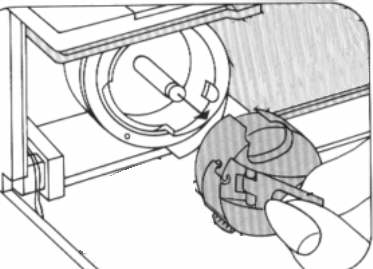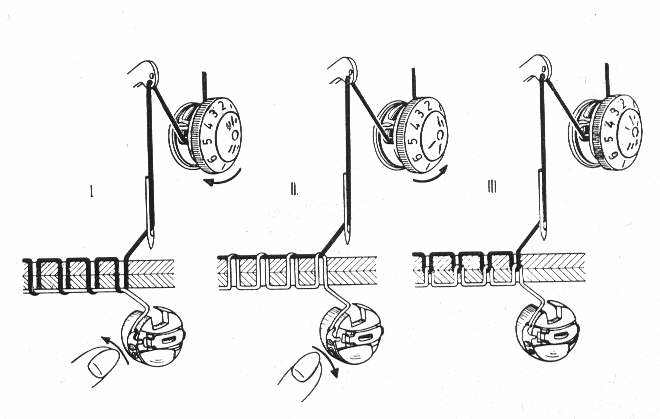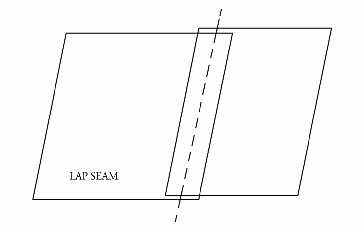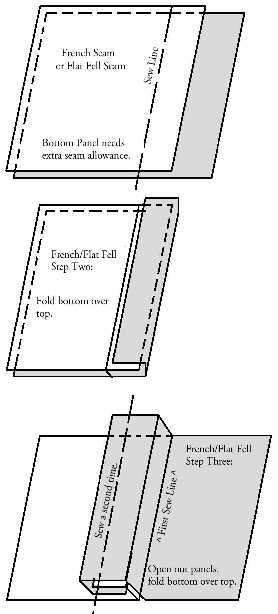|
It's not Kite Making 101, because kites can be made without sewing. It's not Sewing 101, because there are many techniques we will talk about that are unique to sewing kites.This page is an expanded version of what was presented at the American Kitefliers Association National Convention in Ocean City, MD on Wednesday, Oct 2, 2002. As time allows, I'll get back in here and make it a little easier to navigate by either adding frames or anchors. For now, my aim was to get it up first, make it better later.
Sewing Machine thoughts:
Do you absolutely have to have a new machine? If you answered yes, here is a list of what to look for. This is a wish list, a set of guidelines. Perfectly good kites can be made without any of the following items. In the Seminar at Convention it was mentioned that National Grand Champion kites have been made on machines that straight stitch only.
Learn the machine!
RTFM. Read the Manual. Don't have a Manual? - get one! Most stores will copy
one for you.
Threading the machine properly from the spool of thread to the needle is
critical.
Learn the proper thread path for your machine.
Minimum things to know about the machine:
Other things to know about the machine:
Flat bobbin and slant needle machines: All slant needle machines have flat drop-in bobbins. The following bobbin tension technique won't work for flat bobbins machines because the bobbin case and race cannot be conveniently removed. It can still be done, but it is more tedious. The Bobbin still needs to be adjusted first, but it needs to be done with the case in the machine.
Tension:
Sewing kites involves working with thin and slippery material. 'Normal' thread tensions will tend to pucker up the fabric. Kite sewing usually involves much lower tension, both top and bottom.
Setting Bottom Tension (this should be done before adjusting top tension)
Note: At the sewing store, when you buy a machine, they will say: "See
that? That's the bobbin. Don't touch it!"
If you plan to sew ripstop, you will not only need to touch it, you will need to
become very comfortable with adjusting it on a regular basis for every different
thread you intend to use.



Setting Top Tension

In the illustration above, (I) the bottom tension is tighter than the top. (II) shows top tension tighter than bottom, (III) shows ideal tension with both threads meeting in the middle. Using two different colored threads of equal thickness makes it easier to see the differences for adjustment.
Needle: It is tempting to think of the needle as simply poking the thread through the fabric to sew. That is only a small part of the picture. Think of the needle as a delivery system to get the top thread to the bobbin race so the rest of the sewing machine can complete the stitch. The thickness of the thread, the groove in the side of the needle, the scarf on the back of the needle, the size of the eye of the needle, and the size of the hole the needle makes on the fabric all contribute to how well the actual stitch comes out.
Needle and thread note: How many times would you guess that one section of top thread passes thru the eye of the needle? Once? Twice maybe? Would you believe that using HB-33 thread at 8 stitches to the inch (3 mm), one section of thread passes back and forth thru the eye of the needle 24 times? Actually, that is 24 round trips, which means 48 passes through the eye. Think of that when choosing needles and thread. Small needles with small eyes trying to sew lumpy thread often have tension problems.
Size matters.
Position matters.
Brand matters.
Use the brand that came with the machine, the brand the Manual recommends. There is a relief, a scarf, a 'gouge' on one side of the needle that makes it possible for the bobbin race hook to grab the thread. The shape of this scarf is different on different brands of needles. Different brands of machines require different brands of needles.
Don't sew with a bent or dull needle.
Dull needles make a 'snap' noise in the fabric.
Bent needles will drop stitches, especially in zig-zag.
Thread: One of the most critical components of sewing and most often overlooked.
Fabric: First, some quick notes about Spinnaker
Cloth, or 3/4 ounce ripstop nylon/polyester. Because of its coating, it is very
crisp, almost stiff. It holds a crease very well without ironing. Simply
creasing a hem will give the fabric enough memory for it to stay in place for
sewing.
Nylon ripstop fabric:
Polyester ripstop fabric:
Sewing:
Feed problems: If fabric doesn't want to feed straight, or reliably, it is a problem between the Presser Foot and the Feed Dogs. Things to check:
Seams: Seams join two or more layers of fabric.

Lap seam is simply put one layer over the other and sew. This is what our appliqué seams end up being.

The Plain Seam is the most commonly used seam in kite making.(Some people call this Flat Fell, but the Flat Fell is also called the French Seam.) Match up the edges, and sew. Open out the bottom panel, fold over the sewn part, and sew down again. It is a strong seam that doesn't 'bulk up' with a lot of layers. It is only 3 layers deep.
 |
The Mock French Seam is slightly more complicated than the Plain Seam.
People who are obsessed about not leaving a 'raw' edge use this seam
because it is easy to plan for, easy to sew, and hides the raw edge. (Note:
Raw edges in ripstop nylon are not the problem they are in other fabrics. I
need to confess that in 15 years of making kites I have never used this
seam.)
The Mock French Seam starts out just like the Plain Seam. After the bottom panel is opened out, the sewn flap is folded in half, with the raw edge going between the flap and the bottom panel. Then the folded flap is sewn down. This gives a very finished look, but is not a good idea where may seams will overlap, since it is 5 layers of fabric thick. |
 |
The French (or Flat Fell) Seam is the seam you see running down the
outside of your jeans. It is a very strong seam and is frequently used in
tents and jeans and hot air balloons. It is also called Full French or
Double French to distinguish it from the Mock French.
It is more complicated to sew because the bottom layer needs to have 2 seam allowances added instead of one. It takes a lot of planning to use one of these seams. The Franch Seam is better than the Mock French in that it is only 4 layers of fabric thick instead of 5. I have used it once or twice when making sides for EZ-Ups, just to prove I could. |
Planning for seam allowances:
Anchoring or stabilizing seams before sewing, holding the panels together:
Sewing a straight seam:
Hems: Edge treatments / edge binding / bias tape / grosgrain tape
Glossary:
Appliqué - applying bits of cloth to add graphics to a surface.
Back tack / back stitch / lock stitch - backing up two or three stitches to lock the beginning or end of a row of sewing.
Basting stitch - very long stitch used to hold something in place temporarily because it is easily ripped out later. Not a good idea when making kites.
Bias tape/Edge Binding - Tape for finishing a fabric edge, especially when the edge is curved. Tape may be made from scraps or purchased at a sewing store/supply house. BIAS TAPE is cut on the bias and stretches to follow a curve very easily. GROSGRAIN TAPE is cut on the grain and doesn't follow a curve as well.
Bobbin - very small spool that holds thread inside the sewing machine and provides the bottom thread on a lockstitch sewing machine.
Bobbin Case - case which holds the bobbin and controls the tension of the bobbin thread as it enters the machine.
Bobbin Race - Part of the sewing machine which holds the Bobbin and Bobbin Case and contains the Bobbin Hook which picks up the Top Thread out of the Needle and pulls it around the bobbin.
Controller pedal -The gas pedal. The foot pedal that controls the speed of the machine,
Denier - Term that denotes the thickness of the thread. It stands for the weight in grams of 9,000 meters of the thread. Basically the bigger the number, the thicker the thread. Common kite sewing deniers are 30 and 33.
Dual feed: An integrated feed foot that is driven to move with the feed dogs to move fabric more easily. See also Walking Foot.
Edge Binding/Bias tape: Tape for finishing a fabric edge, especially when the edge is curved. Tape may be made from scraps or purchased at a sewing store/supply house. BIAS TAPE is cut on the bias and forms a curve very easily. GROSGRAIN TAPE is cut on the grain and doesn't follow a curve as well.
Feed dogs/feed feet - the jagged teeth under the needle that move the fabric thru the machine.
Grain - the threads of the fabric. Cutting along the threads in either direction is cutting on the grain. Cutting in any direction not along the threads is cutting on the bias.
Greige Goods - (pronounced 'gray goods') fabric straight from the weaving loom with no finishing treatments.
Hand wheel: wheel on right side of sewing machine for advancing needle or stitches manually.
Notions - all the other stuff needed to sew. Needles, thread, scissors, etc.
Presser Foot - Feed foot that presses the fabric against the Feed Dogs. Many machines have a means of adjusting the pressure with which the foot presses on the fabric.
Ripper/Seam Ripper - Hand held tool for ripping out stitches.
Ripstop - Fabric woven with thin threads with thicker threads added at regular intervals. Any 'rip' will 'stop' at the thicker thread.
Satin Stitching: Many stitches close together to 'bind' layers of fabric to prevent fraying. Useful for flagcloth appliqué.
Seamstick - double sided sticky tape used to hold layers of fabric together for sewing.
Tension - the part of the machine the controls the amount of 'pull' there is when the stitch is pulled tight. Also, the amount of pull there is when the stitch is pulled tight.
Balance tension - making sure that the top and bottom tensions pull the same amount so the knot or loop where they meet is right between the layers of fabric being sewn.
Thread Path - Path of thread through the sewing machine from the spool to the needle.
Timing - The top of the machine runs everything on top including the needle up and down and zig-zag. The bottom of the machine runs everything on the bottom including the Bobbin Race and the Feed Dogs. Since the needle and the bobbin hook need to be in the same place at the same time, the top and bottom need to be 'timed' to run together smoothly. Sometimes a machine can jump time and the bobbin hook won't pick up the thread no matter what. Time to call the professionals.
Throat Plate - Also called the Aperture Plate. The plate under the needle and Presser Foot where the feed dogs protrude. Usually it is easily removable to clean underneath.
Walking Foot - an after market (sold separately by manufacturers often other than that which made the sewing machine) Presser Foot that has rubber dogs on the bottom that move with the Feed Dogs. Often gives a more reliable feed in slippery fabric than factory Presser Feet.
Warp - when fabric is woven on a loom, these are the long continuous thread that go the entire length of the roll of fabric. These are generally much straighter than the weft, or fill, threads. This means they will stretch less over time.
Weft - in woven fabric, these are the threads carried back and forth by the shuttle and combed into place. They can very crooked and so tend to stretch more than the warp grain of the fabric.
| Sources for kite making supplies: | |
|---|---|
| Kite Studio, 5555 Hamilton Boulevard, Wescosville, PA, 18106 Phone:
610-395-3560
Web: www.kitebuilder.com |
Hang-'em High, 1420 Yale Ave, Richmond, VA, 23224 Phone: 804-233-6155.
Web:
www.citystar.com/hang-em-high |
| Into the Wind, 1408 Pearl Street, Boulder, CO, 80302-5307 Phone:
800-541-0314
Web: www.intothewind.com |
Kathy Goodwinds: The Gasworks Park Kite Shop, Home of Goodwind's Kites 3420 Stone Way North, Seattle WA 98103. Web:
www.gasworksparkkiteshop.com |
Sewing Notions Catalogs:
Nancy's Notions, 333 Beichl Avenue, Beaver Dam, WI 53916
Phone: 800-833-0690 Web:
www.nancysnotions.com
Clotilde, PO Box 7500, Big Sandy, TX 75755-7500
Phone: 800-772-2891 Web: www.clotilde.com
Other sewing links:
www.sewcool.com/pages/links.html
Written by Gary Engvall.
E-mail: gengvall@aol.com
Home page: http://members.aol.com/gengvall/index.html
Kite Events in Northeast USA: http://members.aol.com/gengvall/events.html
